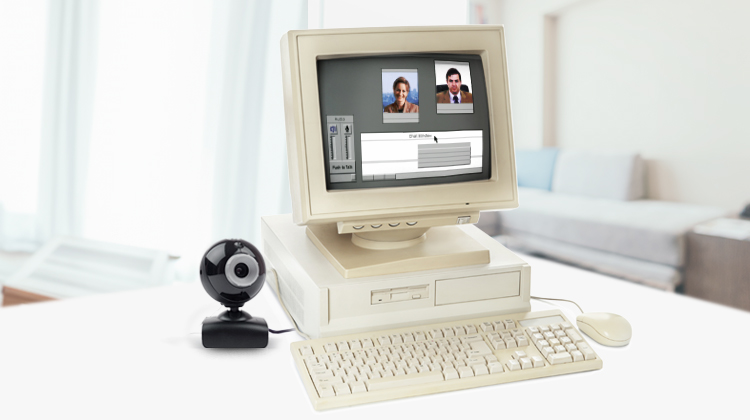Zoom, Microsoft Teams, Google Meet, and Cisco Webex — enterprises are no doubt familiar with these brands as they support employees by sending countless instant messages and enabling video conferences on a daily basis. Video conferencing platforms are the irreplaceable pillars of modern-day businesses. But did you know that the development of video conferencing was a long, bumpy ride?
From the 1880s to 1990s, many had high hopes for video conferencing, yet most early attempts at video teleconferencing had flopped. Before the popularization of the household PC and World Wide Web, video conferencing systems were extremely costly and people were unwilling to adopt these systems to make calls to the limited pool of people who had the systems. However, commercial PCs began entering the household, marking an important turning point for video conferencing.
The Birth of the First PC-based Video Conferencing Software

In 1992, a Cornel Student named Tim Dorcey created the first PC-based video conferencing software called CU-SeeMe. It was released at first supporting 16-gray video and no audio, utilizing low-cost digital cameras to capture images. Later they added in audio reception using microphones, officially becoming the first functional video conferencing system for PCs. Aside from video calling capabilities, it also offered basic text message functionality. CU-SeeMe was a forerunner that laid the groundwork for what was to come.
Soon after, popular instant messaging services like Yahoo Messenger, MSN Messenger, and eventually Skype released video-calling services for desktops and laptops. Upon first release, the programs did not support video, but between 2001 and 2006, these popular messaging software incorporated voice calling and video calling to offer better services for their users. These programs required users to purchase external webcams and microphones though the quality of audio and video for these programs was low due to hardware and internet speed constraints. Even so, the programs made the first internet-based communication accessible to most people who had household computers.
Video Conferencing Programs in Different Sectors

With many consumer segments adopting IP-based video conferencing, different industries were also looking to utilize video conferencing technologies.
Microsoft created Microsoft NetMeeting in 1996, one of the first large-scale uses of video conferencing in businesses. It was popular for meeting amongst a small group of people, helping businesses cut down on travel costs by conferencing with their PC and webcams. In 1997, Caltech-CERN created the Virtual Room Videoconferencing System (VRVS) to help scientists collaborate on the Large Hadron Collider Project. Another interesting use case for medicine happened in 2001, marking the first telesurgery in the world: Operation Lindbergh. Surgeons in New York operated on a patient in Strasbourg, France through the Zeus Robotic System, with the entire system costing up to US$ 975,000. By 2003, WebEx (later acquired by Cisco) introduced its video conferencing feature, targeting businesses with remote teams and improving the video collaboration experience significantly.
The Smartphone Brings Video Conferencing to the Masses

The popularization of the iPhone and other mobile phones and devices brought forth a surge in demand for video calls. Both cable and 3G/4G internet speeds increased, allowing video chat platforms to bring higher-quality video calls to more people. Also, the hardware in these devices were evolving at a considerable pace, so users were no longer required to buy cameras and microphones separately to enjoy decent quality video calls with the built-in cameras and microphones. Video calling platforms like Facetime, Google Hangouts, and Facebook Messenger took advantage of this and helped people easily reach their families and friends anywhere, anytime.
Business-centric Video Conferencing Platforms

Though many business collaboration programs like WebEx, Zoom, BlueJeans, Slack, Skype for business, Microsoft® Teams, and Google Meet were released in the 2010s, business video conferencing platforms began to truly shine during the COVID pandemic, becoming an indispensable part of the modern workplace. The pandemic made businesses realize the importance of a strong internal communication system, especially those that support stable multipoint video calls so that all related members could participate in a conference call. To make remote meetings more efficient, companies also began to utilize specialized video conference cameras and microphones, many of which are certified by video conferencing brands to ensure compatibility with the video conference programs. Certified cameras pass rigorous, precise tests to ensure the best meeting experience. Many of these specialized cameras also offer a variety of additional functionalities, like AI audio tracking which enables the camera to focus on the speaker and audio fence AI technology that blocks out unnecessary background noise. Video conferencing platforms and hardware manufacturers are all harnessing the power of AI and automation in their products, to help enterprises maximize productivity.
Shaping Tomorrow's Video Communication Landscape
The history of video conferencing has been marked by challenges, significant technological advancements, and widespread adoption. As these platforms continue to expand their capabilities, we eagerly anticipate the integration of more AI-driven and automated features, enhancing the way we connect and collaborate. Looking ahead, the future of video conferencing holds exciting prospects, as it continues to advance human communication technology, making virtual interactions more efficient and immersive than ever before. With each passing day, video conferencing not only redefines how we work and communicate but also underscores its indispensable role in shaping the way we connect with the world.